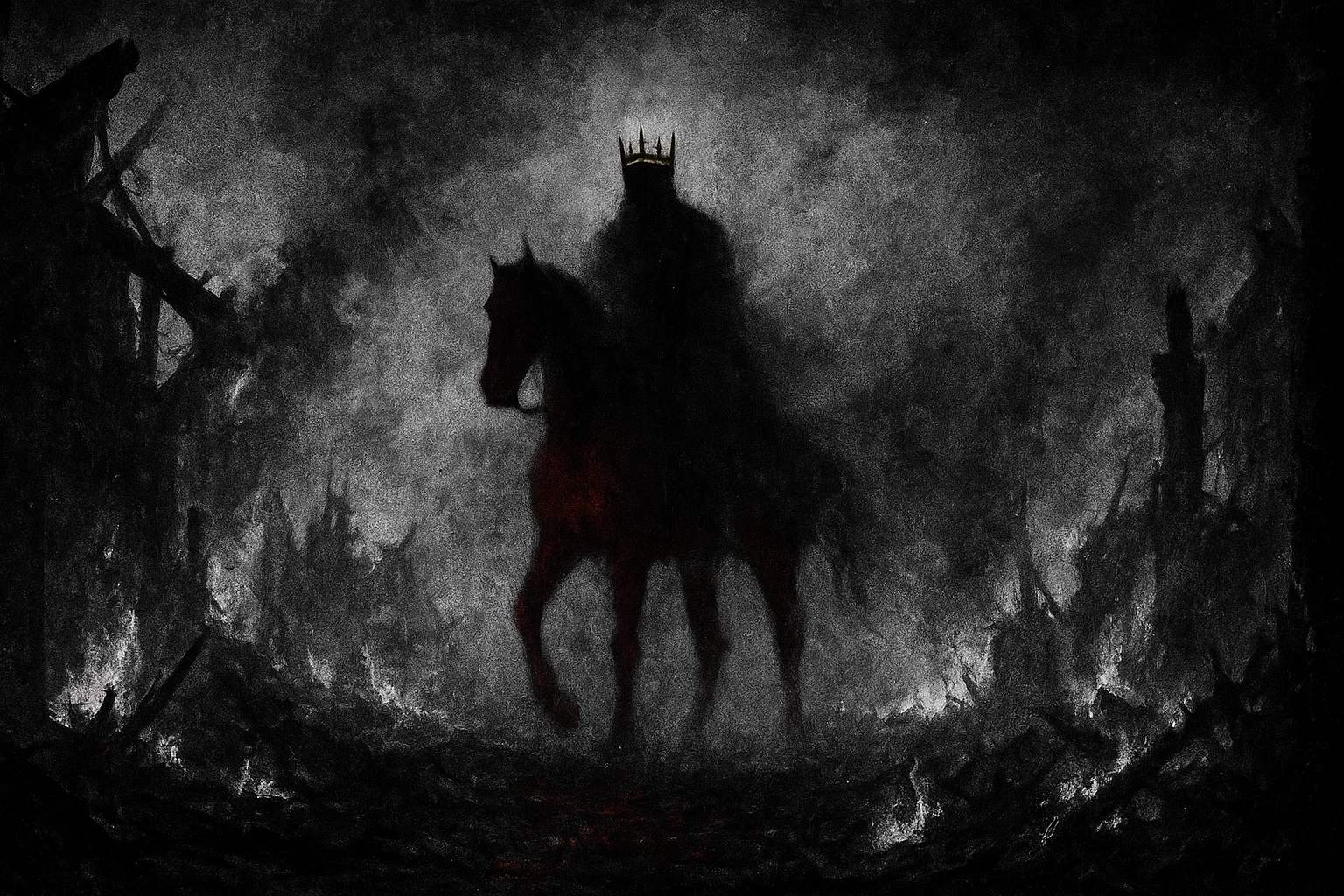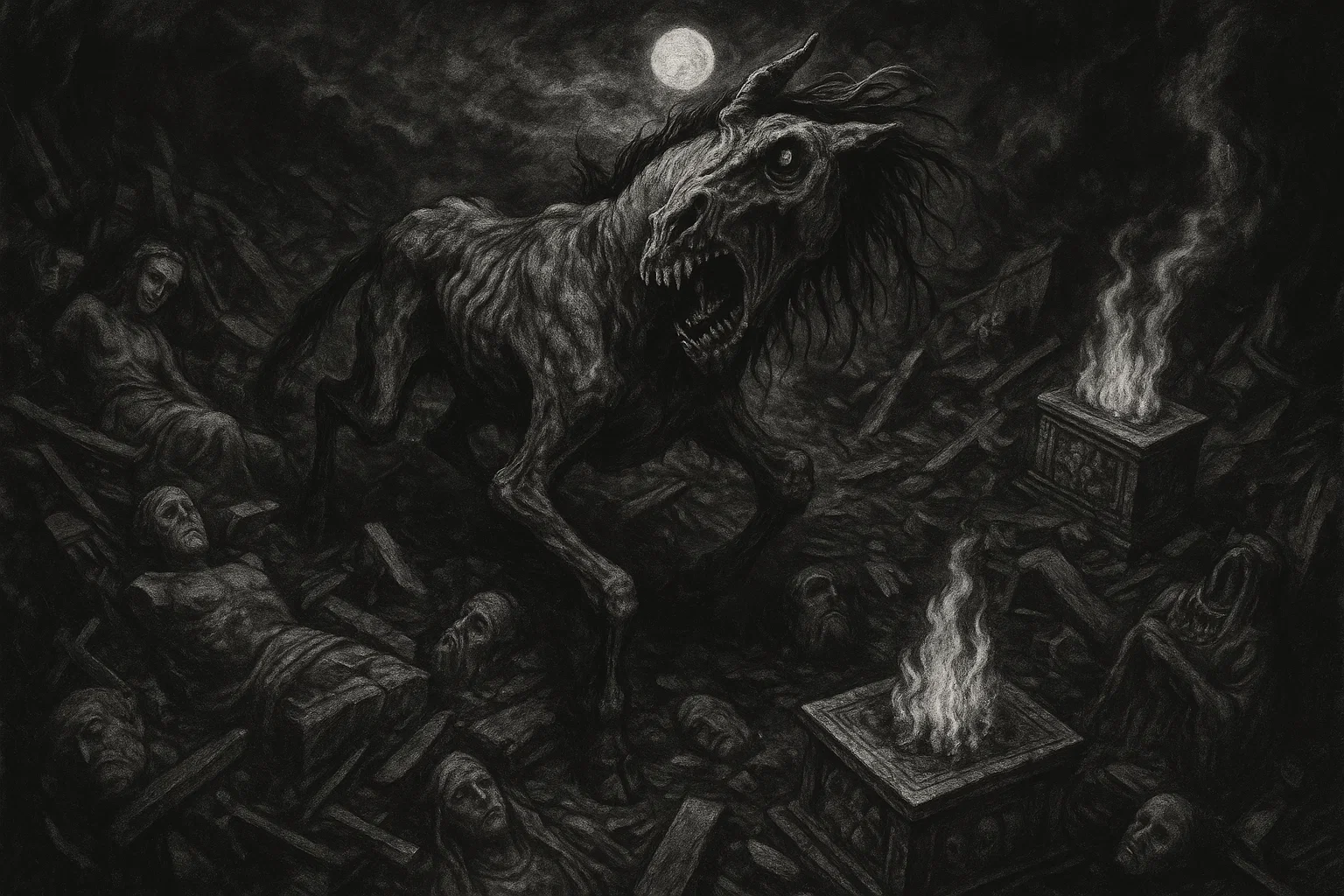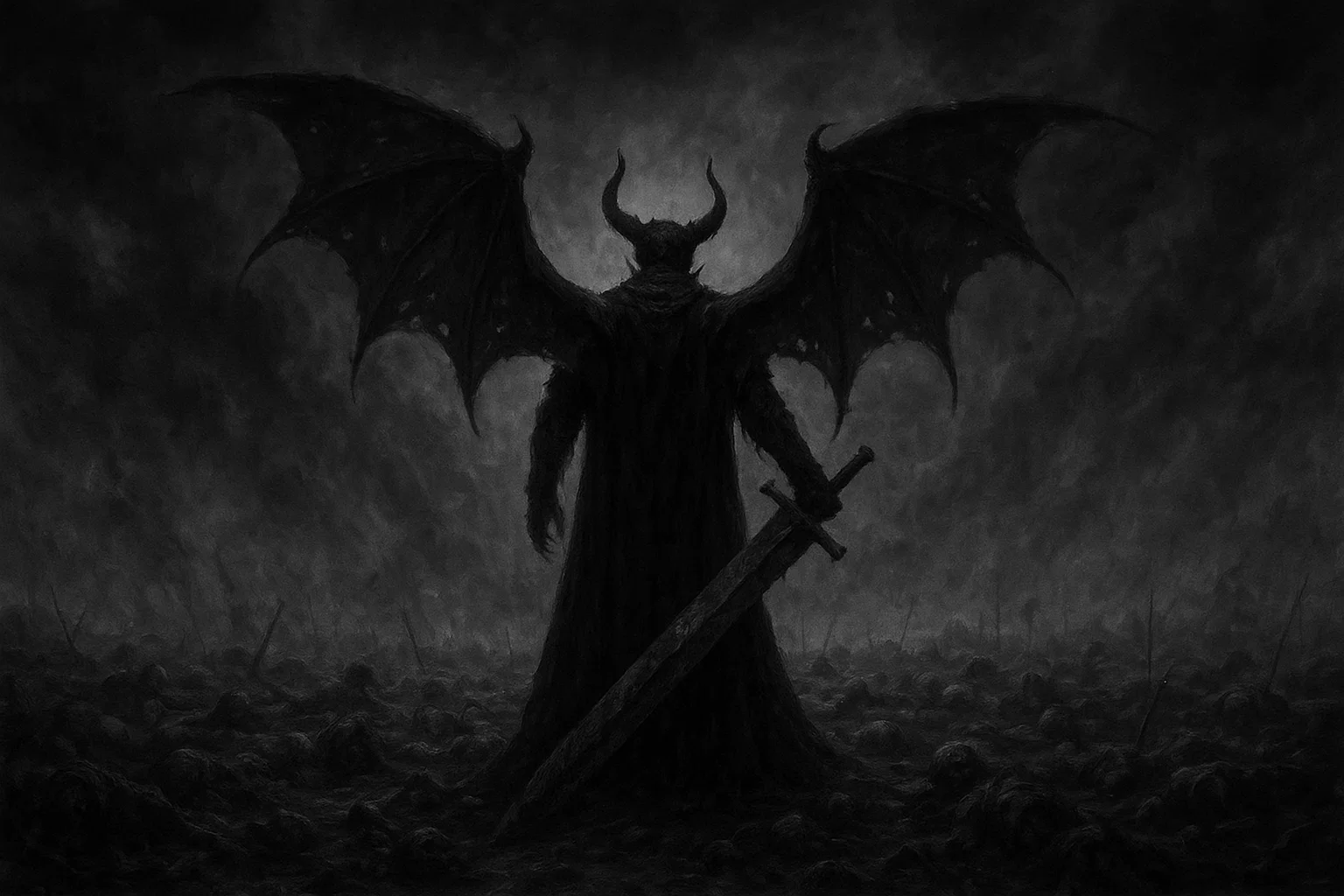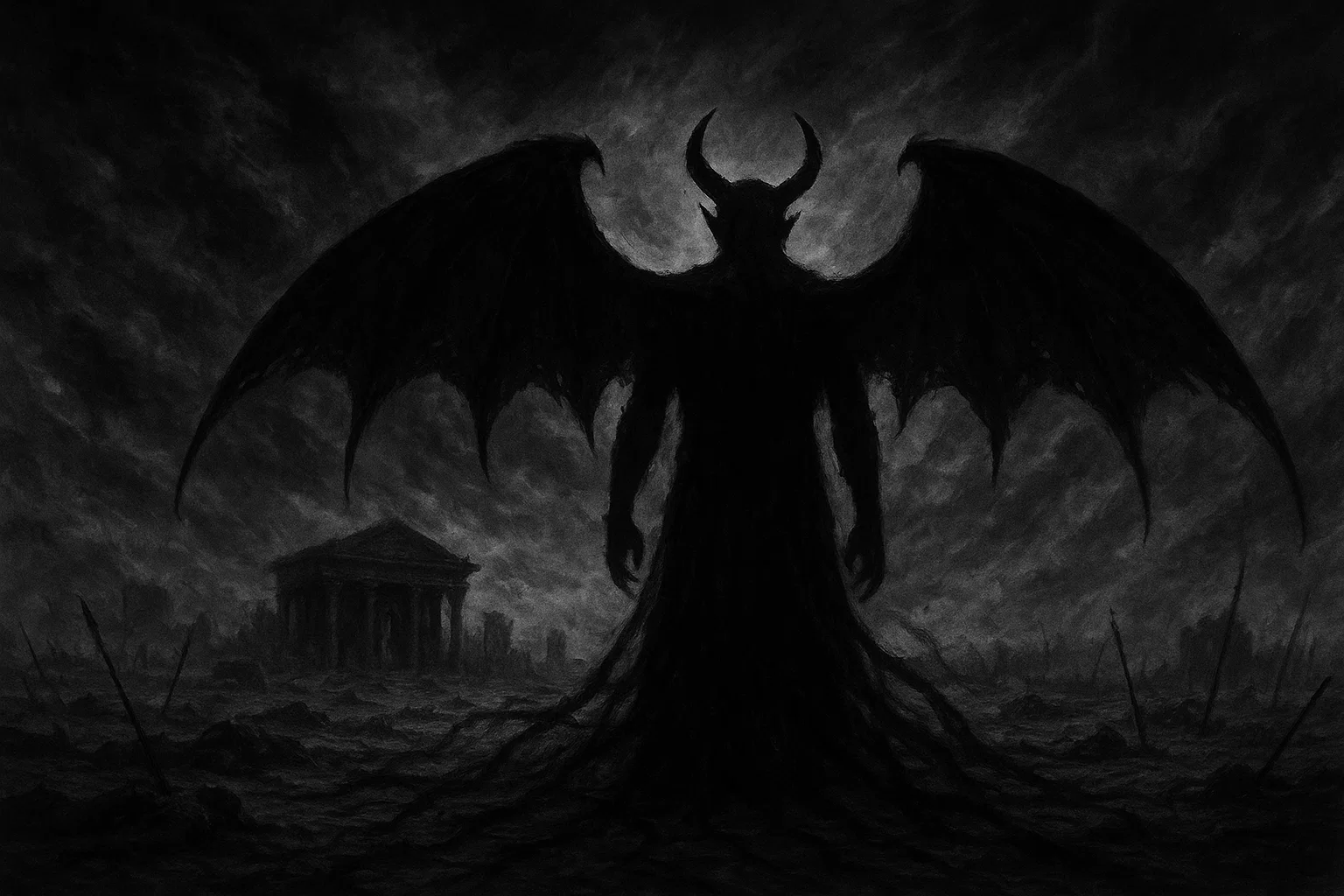Have you ever wondered what ancient force could threaten to swallow the sun and plunge the world into eternal night? What if a single entity embodied all the chaos, disorder, and malevolence that opposes the very essence of light and order?
Apep, the fearsome serpent demon known as Apophis in Greek adaptations, slithers through the annals of Egyptian mythology as the ultimate adversary of the sun god Ra, a being of pure evil intent on disrupting the cosmic balance upheld by Ma’at, the principle of truth and harmony.
This chaos serpent, a manifestation of isfet—the ancient Egyptian concept of disorder and evil—represents the primordial threats that lurk in the shadows of creation. Could such a demon, with its hypnotic gaze and earth-shaking roar, truly challenge the gods themselves? As we delve into the lore of Apep, we uncover tales of nightly battles in the Duat, the underworld realm, where the fate of the world hangs in the balance each dawn.
These stories not only highlight the eternal struggle between good and evil but also raise questions about the nature of chaos: Is it an inevitable force, or can it be vanquished through ritual and divine will?
Table of Contents
Key Information
The following table compiles essential details about Apep, providing a comprehensive overview of his role, attributes, and significance in ancient Egyptian mythology as a demon of pure evil.
| Attribute | Details |
|---|---|
| Name | Apep, Apophis, Apepi, Aapep, Rerek, Aphoph |
| Title | Serpent of Chaos, The Evil Lizard, The Encircler of the World, The Enemy of Ra, Serpent of Rebirth, Lord of Darkness, Embodiment of Isfet |
| Gender | Typically depicted as male, embodying aggressive chaos and destruction |
| Role | Primary antagonist of order and light, personification of chaos (isfet), eternal foe of Ra and Ma’at, bringer of disorder, darkness, and annihilation |
| Hierarchy | Primordial demon outside traditional hierarchies, akin to a supreme lord of chaos; rules over realms of disorder in the Duat, commanding lesser chaotic entities |
| Servitors | Lesser serpents, demons of rebellion, unnamed chaotic minions that assist in ambushes and disruptions; includes fiends like Seshesh the crocodile demon |
| Superior Demon | None; as a primordial force, Apep answers to no one, emerging from the abyss of Nun as an independent entity of evil |
| Powers | Hypnotic gaze for mesmerization, causation of natural disasters (eclipses, storms, earthquakes), soul devouring, regeneration, immense physical strength, illusion creation, darkness manipulation |
| Appearance | Colossal serpent with fiery or obsidian-black scales, piercing emerald or crimson eyes, dragon-like features in some depictions; often shown coiled, dismembered, or pierced by divine weapons |
| Etymology | Rooted in ancient Egyptian ꜥꜣpp, meaning “to slither” or “to lie in wait”; reflects his predatory, insidious nature as a lurking threat |
| Associated Figures | Ra (archenemy), Set (reluctant defender against him), Ma’at (opposing force of order), Neith (possible creator), Horus (ally in battles), Isis (magical protector), Sobek (sibling-like connection in some myths) |
| Weaknesses | Divine spears and spells from Ra and Set, execration rituals involving effigy destruction, amulets inscribed with protective incantations, the power of Ma’at and light |
| Opposing Angel/Saint | No direct angelic equivalent; countered by solar deities like Ra and order-preserving gods upholding Ma’at |
| Equipment/Tools | Massive coils for ensnaring, hypnotic eyes, thunderous roar, venomous fangs, shadowy tendrils for manipulation |
| Pantheon | Ancient Egyptian mythology, with syncretic links to global chaos entities |
Etymology
The name Apep, rendered as ꜥꜣpp in ancient Egyptian hieroglyphs, derives from a root meaning “to slither,” capturing the demon’s serpentine movement and stealthy approach.
This linguistic origin emphasizes Apep’s role as a predatory force, always gliding silently through the shadows to ambush his prey. Scholars trace this term to potential West-Semitic influences, where a similar root ‘pp signifies “to coil” or “to encircle,” aligning with Apep’s epithet as “The Encircler of the World,” a demon who wraps the cosmos in his chaotic grasp.
In Greek adaptations, the name evolves to Apophis, incorporating phonetic shifts that reflect Hellenistic interpretations of Egyptian lore during the Ptolemaic era around 300 BCE. This Hellenized form, Aphoph, sometimes appears in later texts, blending cultural elements while preserving the core idea of a slithering evil.
Additional variants like Apepi or Rerek—the latter possibly linked to a word for “rebel” or “fiend”—further illustrate the demon’s multifaceted nomenclature, each iteration underscoring his rebellious, destructive essence against the ordered world.
Etymological analysis reveals connections to broader Indo-European and Semitic languages, where serpent-related terms often connote deception and danger. For instance, parallels with the Hebrew nahash (serpent) in biblical tales suggest shared archetypal roots for chaos demons.
These linguistic ties not only highlight Apep’s ancient origins but also his enduring symbol as a universal embodiment of malevolence, slithering through myths as the antithesis of creation and harmony.
You May Also Like: Anamelech: The Forgotten Lunar Demon of Ill Omens
What Does the Demon Apep Look Like?
Apep manifests as a gigantic serpent demon, his body stretching to immense lengths—sometimes described as spanning 16 coils or over 120 feet—with scales that gleam like polished obsidian or flicker with infernal fire, symbolizing his chaotic and destructive nature.
His eyes, often depicted as glowing emerald or blood-red slits, radiate a hypnotic allure that can ensnare even the gods, while his maw gapes wide with razor-sharp fangs dripping venom capable of corroding divine essence. In ancient artworks from tombs and papyri dating back to the New Kingdom period around 1550 BCE, Apep appears coiled menacingly, his form twisting in agony from divine wounds, emphasizing his vulnerability yet perpetual threat.
Occasionally portrayed with dragon-like attributes, such as rudimentary limbs or a crocodilian head in syncretic depictions, Apep’s appearance evolves across eras but consistently evokes terror. His skin, textured with ridges that mimic the turbulent Nile floods he inspires, serves as armor against assaults, and his tail ends in a barbed point for lashing out at foes.
These physical traits, detailed in texts like the Book of the Dead, reinforce Apep’s identity as a primordial monster, a visual representation of isfet that strikes fear into the hearts of mortals and immortals alike.
Historical and Mythological Background
Apep’s origins trace back to the earliest strata of Egyptian mythology, emerging from the formless void of Nun, the primordial waters representing pre-creation chaos around 2400 BCE during the Old Kingdom. As a demon born from this abyss, he embodies the raw, unbridled disorder that predates the ordered cosmos established by the creator gods.
Unlike benevolent deities, Apep was never worshipped but ritually reviled, his existence a constant reminder of the fragility of Ma’at. Some myths posit him as spawned from the saliva of Neith, the warrior goddess of creation, or from Ra’s own umbilical cord, positioning him as a twisted sibling to other gods like Sobek, the crocodile deity, and highlighting the paradoxical birth of evil from divine sources.
Connections to global mythologies abound, linking Apep to other chaos serpents and demons. In Babylonian lore, he parallels Tiamat, the saltwater dragon goddess slain by Marduk to form the world, both representing primordial disorder. Biblical Leviathan, a sea monster embodying chaos in Job and Isaiah, shares Apep’s aquatic origins and adversarial role against divine order.
Norse mythology’s Jörmungandr, the Midgard Serpent encircling the earth, mirrors Apep’s world-encircling title and apocalyptic battles, while Níðhöggr, gnawing at Yggdrasil’s roots, echoes his destructive tendencies. Greek Typhon, a serpentine giant challenging Zeus, and Hindu Vritra, the drought dragon slain by Indra, further illustrate universal archetypes of serpentine evil opposing cosmic harmony.
These cross-cultural ties suggest Apep as part of a broader Indo-European and Near Eastern mythological motif, where serpents symbolize the underworld, death, and rebellion. In African folklore, similar entities like the Dahomey Aido Hwedo, a cosmic serpent, invert Apep’s malevolence into creation, but underscore the serpent’s dual potential—though Apep remains steadfastly evil.
His interactions with Egyptian gods reveal complex dynamics: Set, god of storms and disorder, aids Ra against Apep despite his own chaotic nature, perhaps to affirm his loyalty to order. Horus and Isis provide magical support, weaving spells to bind the demon.
The Nightly Battle with Ra in the Duat
Central to Apep’s lore is his eternal conflict with Ra, the sun god, unfolding each night in the Duat. As Ra navigates the underworld in his solar barque, Apep ambushes from hidden lairs, seeking to devour the sun and extinguish light forever. This myth, detailed in the Amduat (Book of What is in the Underworld) from around 1500 BCE, symbolizes the sun’s daily cycle: sunset as Ra’s descent into peril, dawn as his victory. Apep employs his hypnotic gaze to paralyze Ra’s entourage, his coils to capsize the barque, and his roar to summon storms that shake the earth.
Aided by deities like Set, who spears Apep from the prow, and Mehen, the coiled serpent protector, Ra overcomes the demon through incantations and weapons. The battle occurs in specific regions, such as the “Tenth Hour” where Apep is bound by gods, or near Bakhu mountain. Despite dismemberment—his body hacked into pieces—Apep regenerates, ensuring the cycle’s perpetuity. This narrative not only explains natural phenomena like eclipses (when Apep temporarily swallows the sun) but also underscores the need for vigilance against evil.
You May Also Like: Alastor: Greek Avenger Turned Executioner of Hell
Origins and the Creation Myths Involving Apep
In creation tales from the Pyramid Texts circa 2400 BCE, Apep arises from Nun’s chaotic depths, a remnant of the void resisting Atum or Ptah’s ordering acts. One variant claims Apep as a fallen chief god overthrown by Ra, cast into the Duat for tyranny, transforming him into a vengeful demon. Another links him to Neith’s spittle, birthed alongside beneficial gods but corrupted by inherent malice. These origins portray Apep as essential yet antagonistic, a force that defines order through opposition.
Interactions extend to Sobek, sometimes seen as Apep’s kin, blending crocodile and serpent motifs in Nile-based chaos. In Hermopolitan cosmology, Apep disrupts the Ogdoad’s primordial eight deities, attempting to unravel their creative harmony. His presence necessitates protective rituals, influencing Egyptian funerary practices where spells safeguard souls from his devouring maw.
Apep’s Role in Eclipses and Natural Disasters
Apep is blamed for solar eclipses, interpreted as momentary triumphs where he swallows Ra, causing darkness. Texts like the Book of Gates from 1300 BCE describe rituals to aid Ra during these events, with priests chanting to repel the demon. Earthquakes and storms are his wrath manifested, his thrashing coils rumbling the ground, his breath whipping tempests. These associations tied Apep to real-world fears, prompting execration ceremonies where his name was inscribed on pots and smashed.
Interactions with Set and the Complex Alliance Against Chaos
Despite Set’s own chaotic domain, he defends Ra against Apep, spearing the serpent in nightly skirmishes. This reluctant alliance, depicted in New Kingdom art, highlights Set’s redemptive role, contrasting his murder of Osiris. Apep exploits this tension, attempting to corrupt Set with whispers of rebellion, but Set’s loyalty prevails, reinforcing themes of controlled chaos versus utter destruction.
Apep in Funerary Myths and the Afterlife
In the afterlife journey outlined in the Book of the Dead around 1550 BCE, Apep threatens deceased souls, lurking in the Duat to consume them. Protective spells, like Chapter 39, invoke gods to bind and slay him, ensuring safe passage to the Field of Reeds. This role cements Apep as a demon of eternal damnation, opposing resurrection and rebirth.
Historical Mentions
The table below details key historical texts mentioning Apep, offering insights into his evolving depiction as a demon of chaos across millennia.
| Text/Grimoire | Year | Description | Excerpt |
|---|---|---|---|
| Pyramid Texts | c. 2400 BCE | Earliest references to serpentine chaos entities threatening the divine order, identifying Apep as the enemy. | “The serpent-fiend has fallen, his arms are bound, the knife has severed the vertebrae of his back.” |
| Coffin Texts | c. 2000 BCE | Expands on underworld perils, portraying Apep as a devourer of light and souls. | “Apep is repelled by the spells of the gods, his body pierced, his evil dispersed into the void.” |
| Book of the Dead | c. 1550 BCE | Spells to protect the deceased from Apep’s attacks in the afterlife journey. | “Get back, Apep! Thou enemy of Ra, turn thou back, O Apep, whose face is turned back by thy wickedness.” |
| Book of Gates | c. 1300 BCE | Chronicles Apep’s ambushes on Ra’s barque, with gods binding him in chains. | “Apep is overthrown in the presence of Ra, his coils are cut, his head is hacked off by the guardians.” |
| Book of Apophis | c. 1200 BCE | Ritual manual for banishing Apep, including effigy destruction and incantations. | “Trample upon Apep with thy left foot, smite him with thy right hand, chain him with thy magical words.” |
| Amduat | c. 1500 BCE | Describes the twelve hours of the night, with Apep as a recurring threat slain anew each hour. | “The great serpent Apep is felled by Set’s spear, his body divided, his essence scattered in the Duat.” |
| Bremner-Rhind Papyrus | c. 312 BCE | Late period rituals against Apep, emphasizing his role in causing cosmic disruptions. | “Apep, thou art slain, thy head is cut off, thy body is burnt, thy name is forgotten in the halls of eternity.” |
Apep’s Powers and Abilities
Apep wields a arsenal of malevolent powers tailored to his role as the demon of chaos, distinguishing him from generic demonic entities through his cosmic-scale disruptions and psychological manipulations.
His hypnotic gaze, a signature ability, mesmerizes victims—gods or mortals—inducing paralysis and vulnerability, allowing him to strike without resistance. This power corrupts by instilling overwhelming fear and doubt, eroding faith in Ma’at and tempting individuals toward disorderly actions like rebellion or despair.
Beyond hypnosis, Apep commands natural disasters, summoning earthquakes by thrashing his coils, storms with his breath, and eclipses by attempting to swallow celestial bodies. These abilities tempt humanity by creating chaos that fosters survival instincts over ethics, leading to looting, violence, or abandonment of societal norms.
His regenerative capability ensures persistence, symbolizing evil’s resilience and corrupting through the illusion of inevitability.
Soul consumption targets the deceased in the Duat, devouring essences to prevent afterlife bliss, tempting the living with nihilism and moral decay. Immense strength allows him to ensnare divine vessels, while illusion creation weaves deceptive visions, luring victims into traps.
In modern pop culture depictions, such as in the television series Stargate SG-1 where Apophis is a parasitic alien lord, he gains enhanced abilities like energy manipulation and possession, reflecting contemporary fears of invasion and control.
In video games like Age of Mythology, Apep summons minions and unleashes dark magic, expanding his corrupting influence to digital realms. Literature and comics, including references in The Kane Chronicles by Rick Riordan, portray him with shadow tendrils and reality-warping, tempting characters with power at the cost of chaos.
These newer powers amplify Apep’s traditional arsenal, portraying him as adaptable evil in urban fantasy, where he might corrupt through technology glitches or psychological horrors. His roar, echoing thunder, instills terror that breaks wills, while venom corrodes both flesh and spirit, symbolizing gradual moral erosion.
You May Also Like: Is Ahriman the Oldest Demon in History?
Powers and Abilities Breakdown
| Power/Ability | Description | Source | How It Tempts/Corrupts Humans | Countermeasure |
|---|---|---|---|---|
| Hypnotic Gaze | Transfixes targets, inducing paralysis and susceptibility to attacks. | Book of Gates | Paralyzes resolve, tempting surrender to fear and chaos. | Protective spells from Isis or amulets of Ma’at. |
| Natural Disaster Causation | Triggers earthquakes, storms, thunder, and eclipses through physical manifestations. | Pyramid Texts | Instigates panic and survivalism, leading to ethical lapses. | Rituals invoking Ra’s light to dispel darkness. |
| Soul Consumption | Devours souls in the afterlife, erasing existence. | Book of the Dead | Promotes nihilism, encouraging hedonism without consequences. | Funerary incantations and offerings to Osiris. |
| Regeneration | Reforms after dismemberment, embodying eternal evil. | Amduat | Fosters despair over evil’s persistence, tempting apathy. | Repeated divine assaults by Set and allies. |
| Immense Strength/Coils | Ensnare and crush divine or mortal targets with colossal coils. | Book of Apophis | Overpowers physically, symbolizing inevitable domination. | Spears and chains wielded by gods like Horus. |
| Illusion Creation | Generates deceptive visions to mislead and trap. | Coffin Texts | Deceives senses, leading to misguided actions and betrayal. | Truth-revealing magic from Thoth. |
| Darkness Manipulation | Summons shadows to obscure light and enhance stealth. | Modern pop culture (e.g., games) | Amplifies inner darkness, tempting hidden sins. | Solar invocations and light-based rituals. |
| Energy Possession | In pop culture, possesses hosts to spread influence. | Stargate SG-1 depictions | Corrupts from within, turning allies into enemies. | Exorcism-like banishments using ancient spells. |
| Minion Summoning | Calls forth lesser demons or serpents for aid. | Age of Mythology | Overwhelms with numbers, encouraging mob mentality. | Collective divine forces uniting against chaos. |
| Reality Warping | Alters perceptions or environments in fictional narratives. | The Kane Chronicles | Distorts truth, tempting rejection of reality for fantasy. | Anchoring rituals to Ma’at’s order. |
How to Counter Apep’s Powers
Countering Apep’s insidious powers demands a multifaceted approach rooted in ancient Egyptian rituals, divine alliances, and spiritual fortitude. Primary defenses involve invoking Ra and his allies during vulnerable times like dusk or eclipses, using incantations from the Book of the Dead to bind his hypnotic gaze and prevent mesmerization.
Execration rituals, performed by priests in temples, entail crafting wax or clay effigies of Apep, inscribing his names, and destroying them through stabbing, trampling, or burning, symbolically dispersing his chaos.
Protective amulets, such as the Wedjat eye of Horus or scarabs symbolizing rebirth, ward off his soul-consuming tendencies, while spells chanted in unison amplify Ma’at’s order against his disruptions. For natural disasters, offerings to Set harness his spear-wielding prowess to pierce Apep’s coils.
In the afterlife, equipping tombs with anti-Apep texts ensures safe passage. Modern adaptations suggest psychological countermeasures, like mindfulness to resist illusions, but traditional methods emphasize communal rituals to reinforce cosmic harmony.
Weakening Apep also involves daily affirmations of Ma’at through ethical living, as moral decay invites his influence. Group ceremonies during New Year festivals, where Apep’s effigies are publicly annihilated, build collective resistance. Divine interventions, such as Isis’ magic or Thoth’s wisdom, provide intellectual counters to his deceptions.
Apep’s Role in the Hierarchy of Hell
In framing Apep within a demonic hierarchy—though rooted in Egyptian cosmology rather than Christian Hell—he occupies a supreme position as a primordial overlord of chaos, ruling the abyssal depths of the Duat akin to a hellish underworld. As the embodiment of isfet, Apep commands vast armies of lesser demons, including serpentine minions and “children of rebellion,” shadowy fiends that swarm during his assaults on order.
These subordinates, unnamed but described in texts as chaotic entities aiding his ambushes, execute his will by spreading disorder, such as inciting storms or plaguing souls.
Without superiors, Apep operates as an autonomous force, emerging from Nun’s void beyond any chain of command, making him a peer to archdemons in other traditions. Notable allies include tangential chaos figures like Set in moments of shared disruption, though Set ultimately betrays this by defending Ra.
Adversaries abound: Ra as his eternal foe, Horus as the avenger piercing his form, Isis countering with magic, and Ma’at as the conceptual antithesis eroding his power.
In syncretic demonology, Apep might rank alongside high-level entities like Lucifer for rebellion or Leviathan for aquatic terror, governing a “hell” of turbulent waters and darkness. His realm in the Duat’s lower strata features labyrinthine caves where tormented souls face eternal consumption.
Relationships are adversarial; no true alliances endure, as Apep’s malevolence isolates him, though he manipulates lesser demons like Ammit hybrids for devouring duties. This position underscores his role as chaos incarnate, disrupting even hellish hierarchies with unrelenting evil.
You May Also Like: The SS Ourang Medan’s Last Call | Horror Story
Astrological Associations and Symbolism
Apep’s astrological and symbolic ties deeply reflect his chaotic, destructive essence, associating him with elements that evoke darkness and turmoil. The element of water, drawn from his origins in Nun’s primordial ocean, symbolizes fluid, uncontrollable disorder, while earth represents the quakes he induces.
Fire appears in his fiery scales and breath, denoting consuming rage, and air through storm winds. Planets like Pluto govern transformation via destruction, Saturn imposes restrictive chaos, and Mars fuels his aggressive battles.
Colors black and crimson dominate, black for abyssal darkness and crimson for bloodshed and danger. Metals such as iron, forged in conflict, and lead, heavy with oppression, align with his might. Crystals like obsidian shield yet mirror his shadowy nature, black tourmaline repels but embodies negativity, and garnet evokes his bloody eyes. Zodiacally, Scorpio captures his venomous, transformative malice, with Capricorn’s persistence echoing regeneration.
Numbers lack specificity, but infinity symbolizes his eternal return. Days link to night, particularly new moons for heightened evil. These associations guide rituals, using opposing symbols—like gold for Ra—to counter him.
The following table summarizes Apep’s astrological and symbolic connections:
| Element | Association/Symbolism |
|---|---|
| Element | Water (primordial chaos), Earth (earthquakes), Fire (destructive rage), Air (storms) |
| Number | Infinity (eternal regeneration); 7 (hours of battle in some myths) |
| Day | Nighttime, new moon phases, eclipses for peak malevolence |
| Metal | Iron (strength in conflict), Lead (oppressive weight) |
| Precious Stone/Crystal | Obsidian (dark protection), Black Tourmaline (negative energy), Garnet (blood-like fury), Onyx (shadow absorption) |
| Color | Black (darkness), Crimson/Red (danger, blood), Deep Blue (abyssal depths) |
| Zodiac | Scorpio (venom, transformation), Capricorn (persistent evil) |
| Planet | Pluto (destruction, rebirth), Saturn (restriction, chaos), Mars (aggression) |
Apep’s Sigil
While Apep lacks a formalized sigil in traditional grimoires—unlike later European demons—his symbolic representation centers on the coiled serpent motif, often inscribed in reverse or dismembered forms for banishment. Ancient Egyptians used hieroglyphic depictions of a pierced snake as protective “sigils,” carved on amulets or temple walls to invoke repulsion.
In occult interpretations, a stylized loop of his name ꜥꜣpp encircled by flames serves as a modern sigil, evoking his encircling threat and fiery demise.
Associated Symbols and Offerings
| Symbol/Item | Association/Meaning | Use in Rituals |
|---|---|---|
| Serpent | Chaos, deception, primordial evil; core form of Apep. | Effigies crafted and destroyed in execration rites. |
| Obsidian | Darkness, reflection of inner chaos; protective yet malevolent. | Amulets to ward off, or shards to symbolize breaking his power. |
| Incense (Myrrh) | Purification against evil; smoky veil mimicking shadows. | Burned to repel Apep during banishment ceremonies. |
| Papyrus | Inscribed knowledge; order contrasting chaos. | Scrolls with spells burned alongside effigies. |
| Spear | Weapon of Set; penetration of evil. | Used symbolically to stab representations of Apep. |
| Black Candle | Darkness invocation; but extinguished for banishment. | Lit then snuffed in rituals to symbolize defeating his night. |
| Red Ochre | Blood and danger; marks of his wounds. | Painted on effigies to represent divine victory. |
| Clay Ball | Fragile form for destruction; eye of Apep. | Smashed in ceremonies to crush his gaze. |
You May Also Like: Sloss Furnaces Haunting: Real Ghosts or Tourist Trap?
Comparison with Other Demons
The table below compares Apep with other demons from various mythologies, highlighting thematic parallels and distinctions in their roles as forces of evil.
| Demon | Pantheon | Role | Powers | Appearance | Weaknesses |
|---|---|---|---|---|---|
| Tiamat | Babylonian | Primordial chaos mother | Creation of monsters, sea storms | Multi-headed dragon | Slain by Marduk’s wind |
| Níðhöggr | Norse | Root-gnawer of the world tree | Decay, corpse devouring | Wingless dragon | Bound eternally to Yggdrasil |
| Jörmungandr | Norse | World-encircling apocalypse bringer | Poison venom, ocean tempests | Immense sea serpent | Killed by Thor’s hammer |
| Leviathan | Judeo-Christian | Sea chaos monster | Floods, soul entrapment | Coiled sea dragon | Divine hook and sword |
| Typhon | Greek | Storm giant, father of horrors | Hurricanes, volcanic eruptions | Hundred-headed serpent | Buried under Etna by Zeus |
| Vritra | Hindu | Drought dragon, water blocker | Drought inducement, illusion | Massive serpent | Slain by Indra’s thunderbolt |
| Eris | Greek | Discord sower | Strife provocation, confusion | Winged goddess | Overcome by harmony gods |
| Set | Egyptian | Storm and desert chaos god | Desert storms, violence | Beast-headed humanoid | Defeated by Horus in trials |
| Lucifer | Christian | Fallen angel, tempter | Deception, pride inducement | Fallen light-bearer | Bound by divine judgment |
| Beelzebub | Judeo-Christian | Lord of flies, corruption | Disease spread, possession | Fly-infested demon | Exorcisms and faith |
Conclusion
Apep, the serpent demon of chaos and darkness, stands as a timeless emblem of malevolence in ancient Egyptian mythology, his relentless assaults on Ra and Ma’at illustrating the perpetual war between disorder and harmony. Through expanded explorations of his origins in Nun, connections to global chaos entities like Tiamat and Leviathan, and detailed myths of cosmic battles, we see a demon whose evil permeates every shadow, tempting corruption through fear and disruption.
His powers, from hypnotic gazes to reality-warping illusions in modern tales, underscore an adaptable threat that evolves yet remains rooted in primordial malice.
As we reflect on Apep’s place in demonic hierarchies, astrological symbols, and ritual counters, his legacy warns of chaos’s insidious creep, urging vigilance in upholding order. In a world still grappling with disorder, Apep’s story endures, a cautionary tale of the abyss that stares back, forever slithering in the dark.






